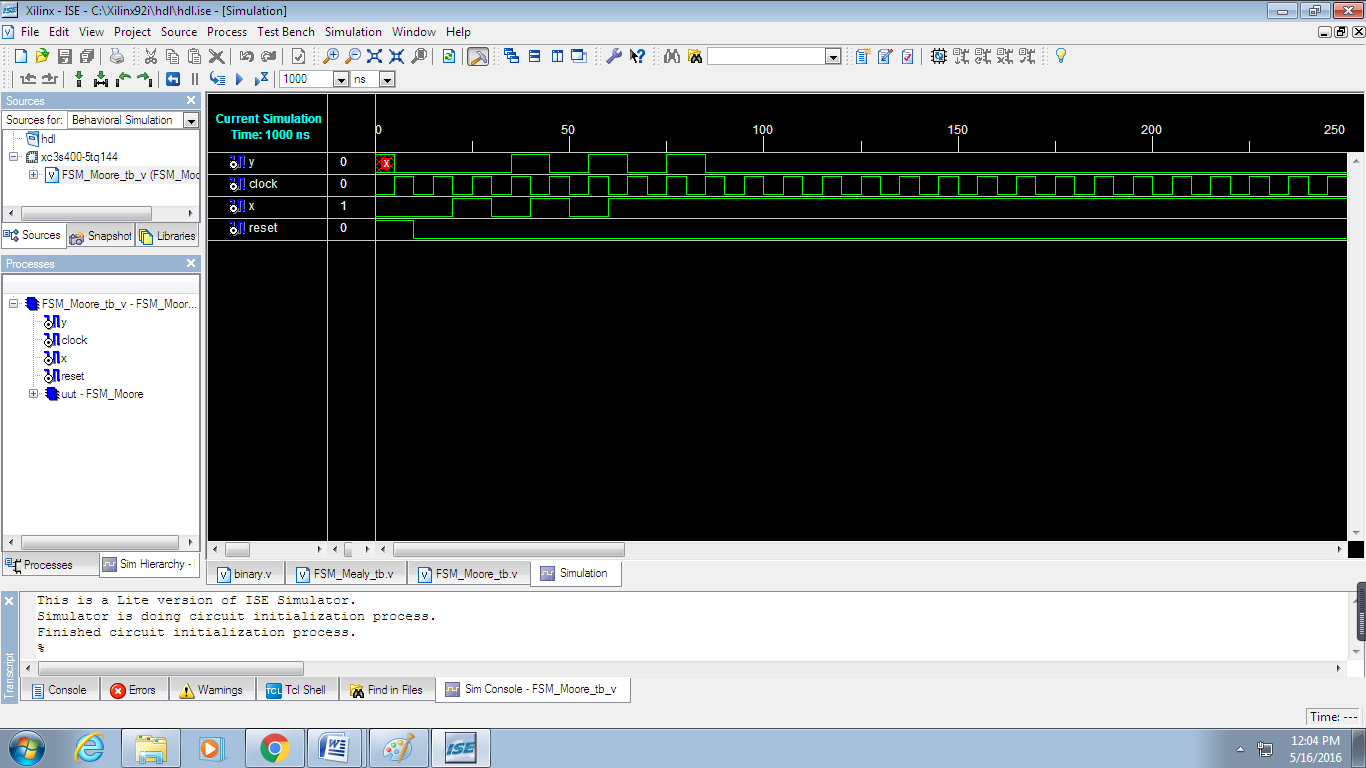Finite State Machine (Moore Machine)
Prerequisites:
Study the functionality of Moore machine.
Learning Objective:
To develop the source code for Moore machine by using VERILOG and obtain the simulation and synthesis.

Software and Hardware:
Xilinx ISE 9.2i and FPGA Spartan-3E.
Theory:
In the theory of computation, a Moore machine is a finite state machine where the outputs are determined by the current state alone (and do not depend directly on the input). The state diagram for a Moore machine will include an output signal for each state, Compared with a Mealy machine, which maps transitions in the machine to outputs.
- The advantage of the Moore model is a simplification of the behavior

| Present State | Next State | Output | ||
|---|---|---|---|---|
| X = 0 | X = 1 | X = 0 | X = 1 | |
| S0 | S1 | S0 | 0 | 0 |
| S1 | S1 | S2 | 0 | 1 |
| S2 | S1 | S0 | 0 | 0 |
Block Diagram:

Verilog Code:
module FSM_Moore(y, x, clock, reset);
input x, clock, reset;
output y;
reg y;
reg [1:0] Next_state;
parameter s0 = 2'b00, s1 = 2'b01, s2 = 2'b10;
always @ (posedge clock)
begin
if (reset)
begin
Next_state = s0;
y = 1'b0;
end
case (Next_state)
s0:begin
y = 1'b0;
if (x)
Next_state = s0;
else
Next_state = s1;
end
s1:begin
y = 1'b0;
if (x)
Next_state = s2;
else
Next_state = s1;
end
s2:begin
y = 1'b1;
if (x)
Next_state = s0;
else
Next_state = s1;
end
endcase
end
endmodule
TEST BENCH:
module FSM_Moore_tb_v;
// Inputs
reg x;
reg clock;
reg reset;
// Outputs
wire y;
// Instantiate the Unit Under Test (UUT)
FSM_Moore uut (
.y(y),
.x(x),
.clock(clock),
.reset(reset)
);
initial begin
// Initialize Inputs
x = 0; clock = 0;reset = 1;
#10 x = 0; reset = 0;
#10 x = 1;
#10 x = 0;
#10 x = 1;
#10 x = 0;
#10 x = 1;
// Wait 100 ns for global reset to finish
#100;
// Add stimulus here
end
always #5 clock = ~clock;
endmodule
Simulation Results:
Result: Thus the program for Moore FSM has been verified and also simulation and synthesis reports have been verified.
Learning outcome:
After completion of this experiment, students are able to design moore machine using Verilog code.
Viva Questions:
- What is the function of Moore machine?
- What are the differences between Moore and Mealy machine?
- What is meant by simulation?
- What is meant by synthesis?
- What are advantages of verilog over high level languages?
-
UpdatedOct 17, 2016
-
Views3,833
